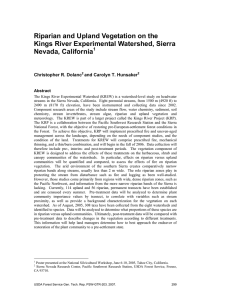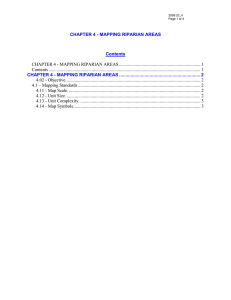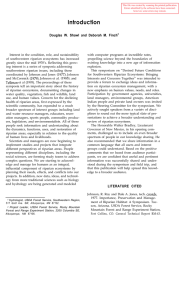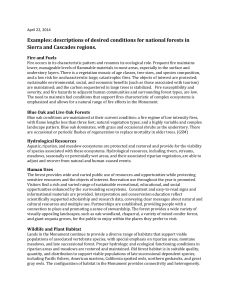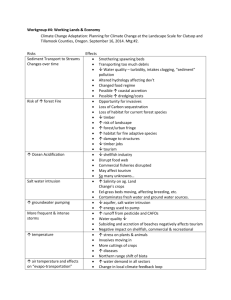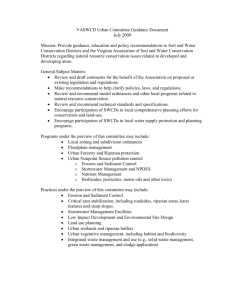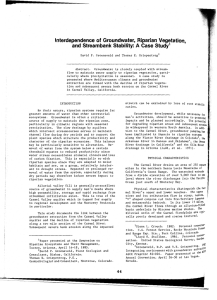POST-FIRE INTERACTIONS BETWEEN RIPARIAN VEGETATION AND
advertisement
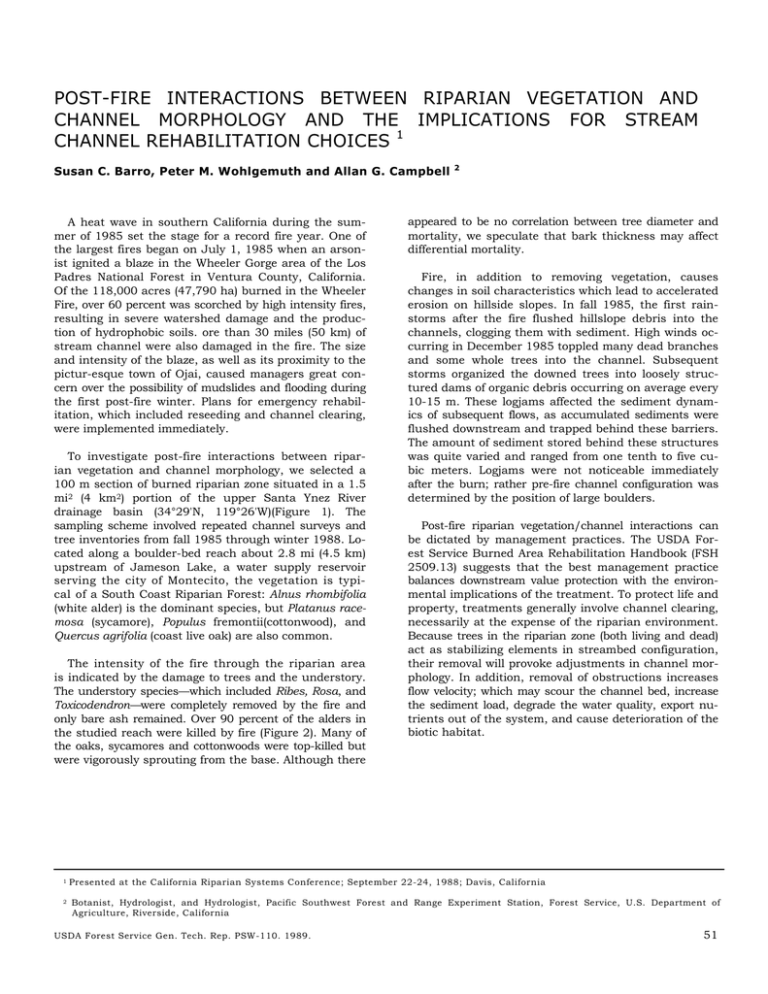
POST-FIRE INTERACTIONS BETWEEN RIPARIAN VEGETATION AND CHANNEL MORPHOLOGY AND THE IMPLICATIONS FOR STREAM CHANNEL REHABILITATION CHOICES 1 Susan C. Barro, Peter M. Wohlgemuth and Allan G. Campbell A heat wave in southern California during the summer of 1985 set the stage for a record fire year. One of the largest fires began on July 1, 1985 when an arsonist ignited a blaze in the Wheeler Gorge area of the Los Padres National Forest in Ventura County, California. Of the 118,000 acres (47,790 ha) burned in the Wheeler Fire, over 60 percent was scorched by high intensity fires, resulting in severe watershed damage and the production of hydrophobic soils. ore than 30 miles (50 km) of stream channel were also damaged in the fire. The size and intensity of the blaze, as well as its proximity to the pictur-esque town of Ojai, caused managers great concern over the possibility of mudslides and flooding during the first post-fire winter. Plans for emergency rehabilitation, which included reseeding and channel clearing, were implemented immediately. To investigate post-fire interactions between riparian vegetation and channel morphology, we selected a 100 m section of burned riparian zone situated in a 1.5 mi2 (4 km2) portion of the upper Santa Ynez River drainage basin (34°29'N, 119°26'W)(Figure 1). The sampling scheme involved repeated channel surveys and tree inventories from fall 1985 through winter 1988. Located along a boulder-bed reach about 2.8 mi (4.5 km) upstream of Jameson Lake, a water supply reservoir serving the city of Montecito, the vegetation is typical of a South Coast Riparian Forest: Alnus rhombifolia (white alder) is the dominant species, but Platanus racemosa (sycamore), Populus fremontii(cottonwood), and Quercus agrifolia (coast live oak) are also common. The intensity of the fire through the riparian area is indicated by the damage to trees and the understory. The understory species—which included Ribes, Rosa, and Toxicodendron—were completely removed by the fire and only bare ash remained. Over 90 percent of the alders in the studied reach were killed by fire (Figure 2). Many of the oaks, sycamores and cottonwoods were top-killed but were vigorously sprouting from the base. Although there 1 2 2 appeared to be no correlation between tree diameter and mortality, we speculate that bark thickness may affect differential mortality. Fire, in addition to removing vegetation, causes changes in soil characteristics which lead to accelerated erosion on hillside slopes. In fall 1985, the first rainstorms after the fire flushed hillslope debris into the channels, clogging them with sediment. High winds occurring in December 1985 toppled many dead branches and some whole trees into the channel. Subsequent storms organized the downed trees into loosely structured dams of organic debris occurring on average every 10-15 m. These logjams affected the sediment dynamics of subsequent flows, as accumulated sediments were flushed downstream and trapped behind these barriers. The amount of sediment stored behind these structures was quite varied and ranged from one tenth to five cubic meters. Logjams were not noticeable immediately after the burn; rather pre-fire channel configuration was determined by the position of large boulders. Post-fire riparian vegetation/channel interactions can be dictated by management practices. The USDA Forest Service Burned Area Rehabilitation Handbook (FSH 2509.13) suggests that the best management practice balances downstream value protection with the environmental implications of the treatment. To protect life and property, treatments generally involve channel clearing, necessarily at the expense of the riparian environment. Because trees in the riparian zone (both living and dead) act as stabilizing elements in streambed configuration, their removal will provoke adjustments in channel morphology. In addition, removal of obstructions increases flow velocity; which may scour the channel bed, increase the sediment load, degrade the water quality, export nutrients out of the system, and cause deterioration of the biotic habitat. Presented at the California Riparian Systems Conference; September 22-24, 1988; Davis, California Botanist, Hydrologist, and Hydrologist, Pacific Southwest Forest and Range Experiment Station, Forest Service, U.S. Department of Agriculture, Riverside, California USDA Forest Service Gen. Tech. Rep. PSW-110. 1989. 51 Channel clearing is often undertaken even when life and property are not at risk. If downstream values include water supply or flood control reservoirs (as along the Santa Ynez River), a more appropriate course of action may be to leave the burned riparian zone intact. While more sensitive to debris flows produced by catastrophic storms, during more moderate events, obstructions will dissipate some of the flow energy, and the in- creased sediment storage capacity will buffer the sedimentation impacts downstream. Logjams will create a stepped channel gradient, resulting in a slower routing of nutrients, increased water quality, and greater habitat diversity. Although logjams constitute an additional channel configuration parameter, ascertaining the influence of specific obstructions on channel morphology was beyond the scope of this study. Figure 1—Location map of the study area on the upper portion of the Santa Ynez River 52 USDA Forest Service Gen. Tech. Rep. PSW-110. 1989. NUMBER OF INDIVIDUALS Figure 2—Tree species frequency and degree of mortality within the study area USDA Forest Service Gen. Tech. Rep. PSW-110. 1989. 53

